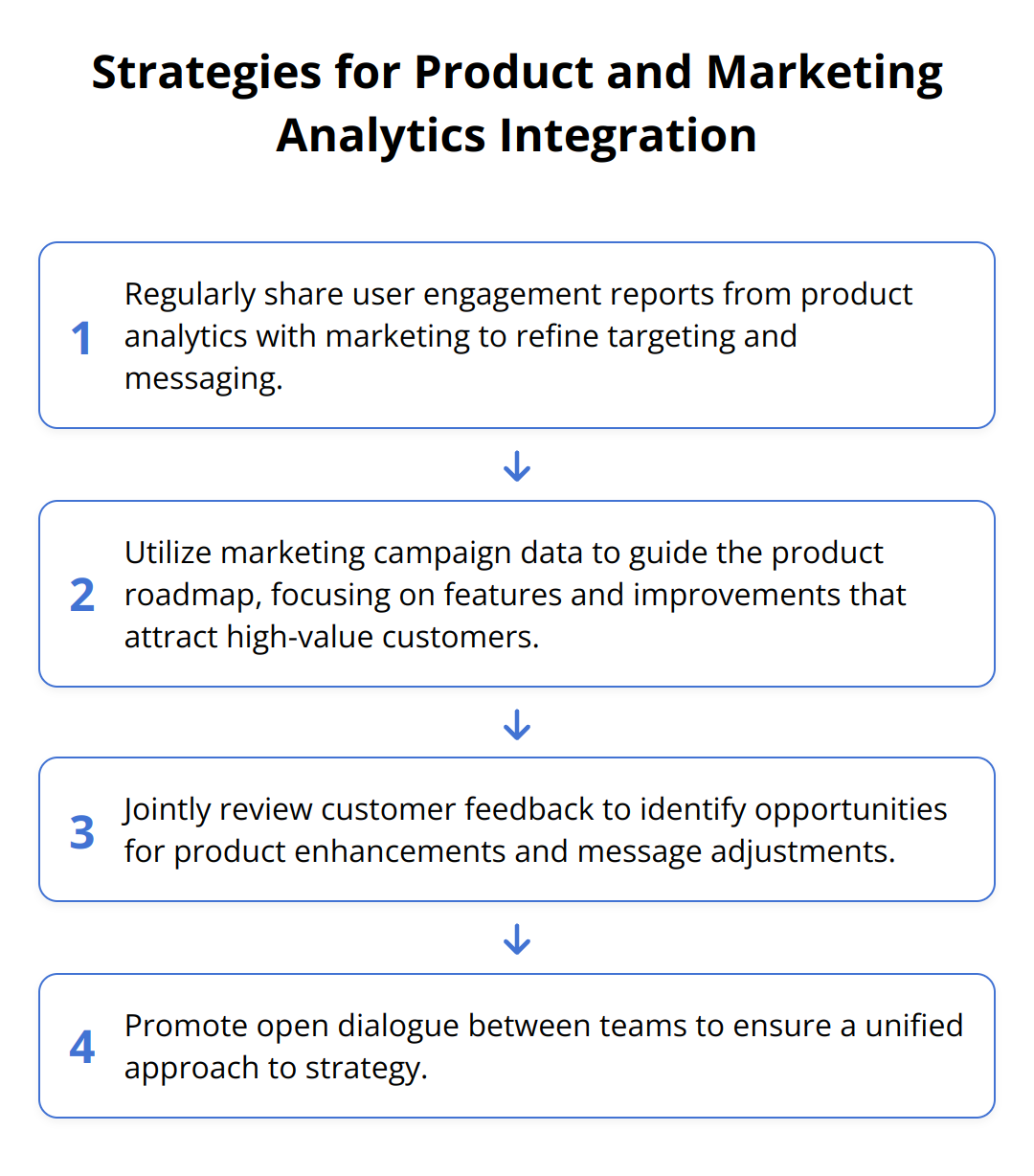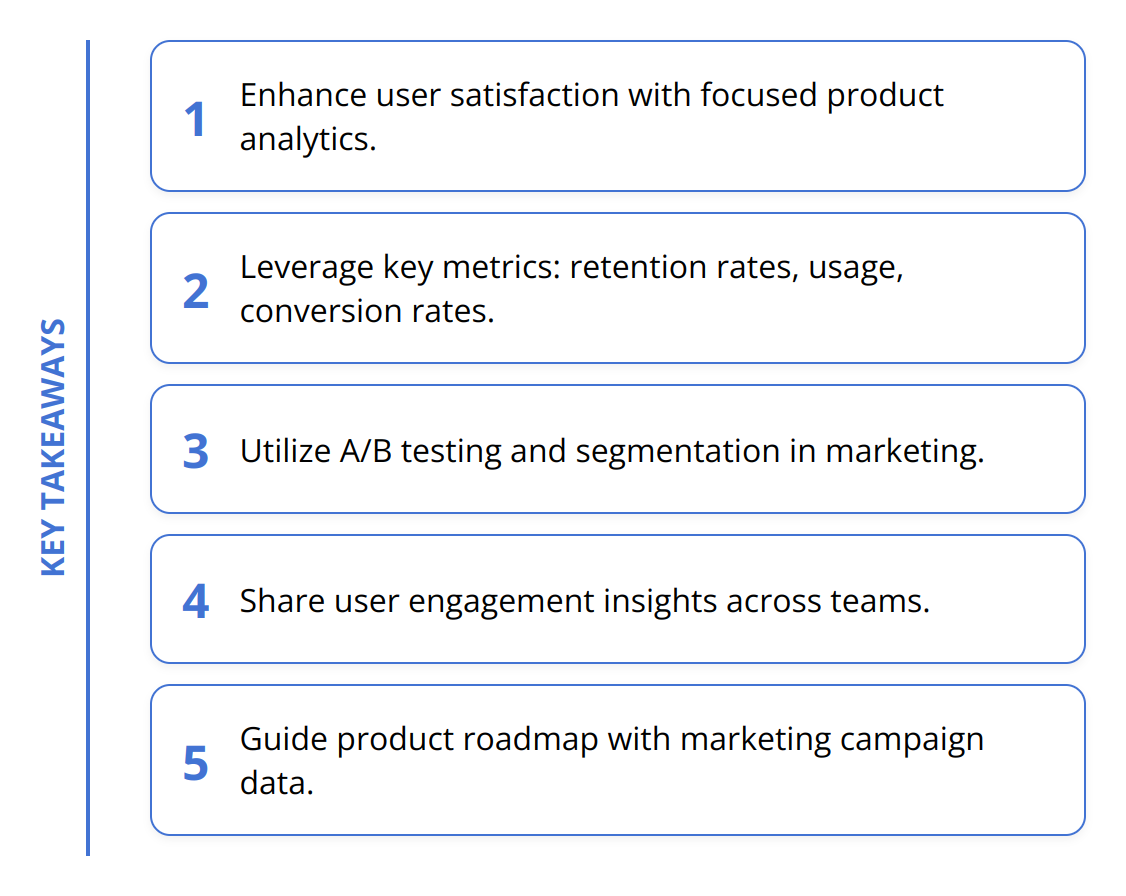Navigating the landscape of business analytics can often feel overwhelming, yet understanding the nuances between different types is key to leveraging data effectively. We at Emplibot recognize the importance of distinguishing product analytics from marketing analytics. Each serves unique objectives and employs distinct methods for data analysis and application. This post aims to demystify these differences, highlight their areas of impact, and explore how businesses can integrate both to drive growth.
Understanding Product Analytics
In the world of business analytics, product analytics emerges as a pivotal tool for honing in on the user experience and refining product development. This sphere of analytics focuses intensely on how users interact with a product, aiming to unlock insights that can lead to improved engagement, feature usage, and ultimately, customer retention.
The Essence of Product Analytics
At its core, product analytics is about gathering and analyzing data related to how users engage with a product. This includes everything from the features they use most to the obstacles they encounter. The primary goal here is to enhance user satisfaction by making data-informed decisions that steer product improvements and innovations.
Vital Metrics and Tools
A variety of metrics are at the heart of product analytics, each offering insights into different aspects of user behavior and product performance. Key metrics include user retention rates, feature usage, and conversion rates from free trials to paid subscriptions. Tools like Mixpanel and Amplitude stand out for their capability to drill down into these metrics, providing a nuanced view of user engagement and behavior patterns.

For a deeper dive into how data analytics is revolutionizing marketing, visit our blog on data analytics in marketing.
Impact on Product Development
The real power of product analytics lies in its impact on product development. By understanding user behaviors and preferences, product teams can prioritize features that offer the most value and rework or eliminate those that don’t. This also includes identifying technical issues or UI/UX obstacles that may be hindering user satisfaction or product performance.
For instance, if analytics reveal a high drop-off rate at a certain feature, this signals an opportunity for redesign or enhancement. Similarly, trends in feature usage can inform the development of new, related features that cater to user interests and needs.
Enriching User Experience
Ultimately, the insights derived from product analytics play a crucial role in enriching the user experience. By tailoring product improvements to meet user needs and preferences, businesses can foster higher engagement levels, boost retention, and drive growth. This user-centric approach not only enhances the product itself but also strengthens customer loyalty and competitive edge.

In summary, product analytics stands as a cornerstone of effective product development and user experience enhancement. By leveraging the right metrics and tools to understand user behavior, businesses can make informed improvements that resonate with their user base, driving satisfaction and success.
The next chapter will explore the landscape of marketing analytics, contrasting its focus and methodologies with those of product analytics, to provide a comprehensive understanding of how these two analytics domains complement each other in driving business growth.
Marketing Analytics Explained
With the stage set by a deep dive into product analytics and its significance in enhancing the user experience, we shift our focus towards marketing analytics and its pivotal role in shaping business strategies and engaging customers effectively. Much like its counterpart, marketing analytics wields substantial influence, albeit with a different set of objectives and tools at its disposal.
Marketing analytics primarily revolves around understanding and optimizing the journey of prospects and customers from initial awareness to the eventual purchase and beyond. It dissects the effectiveness of marketing campaigns across various channels, aiming to maximize return on investment (ROI) and refine targeting strategies.
Key Metrics for Success
Several metrics stand out in marketing analytics due to their direct correlation with business success:
-
Conversion rates reveal the percentage of visitors who take a desired action, offering insight into campaign effectiveness.
-
Customer acquisition cost (CAC) measures the total cost of acquiring a new customer, critical for evaluating marketing efficiency.
-
Customer lifetime value (CLV) assesses the total revenue a business can expect from a single customer account, aiding in long-term planning and budget allocation.
Techniques such as A/B testing and segmentation are indispensable, allowing marketers to tailor their strategies based on real-world data and specific customer groups. Tools such as Google Analytics and HubSpot offer comprehensive capabilities for tracking these metrics and implementing sophisticated marketing tactics.
Shaping Strategies and Engagement
The insights gleaned from marketing analytics directly inform and transform marketing strategies. By identifying the most effective channels and messaging, businesses can allocate their budgets more effectively, focusing on high-ROI activities. Furthermore, understanding customer preferences and behaviors enables the creation of highly personalized and engaging marketing campaigns.
Leveraging data from marketing analytics also significantly enhances customer engagement by enabling businesses to deliver the right message, to the right person, at the right time. Whether through targeted email campaigns, social media engagement, or personalized website content, the goal is to make every interaction as relevant and impactful as possible.
To further explore strategies for effective customer engagement, our guide on email marketing automation offers actionable insights and examples.
Practical Tips for Marketers
-
Routinely analyze your metrics to identify trends and adjust strategies accordingly.
-
Employ segmentation to tailor your messaging and offers to different customer groups.
-
Test continuously through A/B testing to optimize campaign elements for better performance.
-
Focus on improving CLV through strategies aimed at boosting repeat purchases and customer loyalty.
By carefully integrating marketing analytics into their strategy, businesses can significantly increase their marketing effectiveness, driving both engagement and conversions. Understanding the synergy between product and marketing analytics facilitates a holistic approach to business growth, ensuring that both product development and marketing efforts are aligned with customer needs and preferences.

The exploration doesn’t end here, as the next chapter will merge insights from both realms to showcase their combined power in developing a cohesive and robust strategy for business success.
Bridging Product and Marketing Analytics
Understanding the nuanced distinctions between product and marketing analytics sets the stage for leveraging both to achieve a unified goal: sustainable business growth. The interplay between these analytics forms the backbone of a data-driven strategy that balances customer satisfaction with market expansion.
Integrating Goals for Comprehensive Insights
While product analytics zeroes in on user interaction and satisfaction, marketing analytics focuses on customer acquisition and ROI. However, these objectives aren’t mutually exclusive. A product that continually evolves based on user feedback is more likely to engage customers and drive conversions, indicating a symbiotic relationship between the two domains. For example, a high engagement feature identified through product analytics could be the centerpiece of marketing campaigns, enhancing both user retention and acquisition.
Harmonizing Data Analysis for Strategic Decisions
The methods of data analysis in both areas can offer complementary perspectives. Product analytics thrives on detailed behavioral metrics such as engagement levels with specific features or platforms. In contrast, marketing analytics leverages demographic data and campaign performance metrics to optimize strategies across different customer segments. However, when combined, this data can inform more nuanced product development and targeted marketing campaigns. For instance, demographic insights from marketing analytics can help product teams develop features that resonate with specific user segments, enhancing overall engagement.
To further refine your marketing strategy with data, explore our insights on data-driven marketing.
Fostering Team Collaboration for Unified Success
The most significant impact comes from the synergies created through the collaboration of product and marketing teams. When both teams share insights and data openly, they pave the way for a cohesive strategy that boosts both user engagement and customer acquisition. Regular cross-functional meetings and shared analytics dashboards can facilitate this exchange, aligning both teams towards common business objectives.

By embracing the complementary nature of product and marketing analytics, companies can develop products that not only meet user needs but also efficiently attract new customers. The integration of these analytics forms encourages a holistic approach to business strategy, where every decision is informed by a deep understanding of both user behavior and market trends.
Navigating the juncture of product and marketing analytics offers a potent strategy for sustaining growth, enhancing user satisfaction, and achieving market prominence. The next chapter will delve into practical steps for implementing these insights into your business strategy, ensuring you harness the full potential of your data analytics endeavors.
Final Thoughts
In navigating the complex world of business analytics, distinguishing between product and marketing analytics is essential. While product analytics focuses on enhancing the user experience through detailed interaction data, marketing analytics aims at optimizing customer acquisition strategies and maximizing ROI through campaign data analysis. Despite these differences, both play a pivotal role in business growth, offering unique insights that, when integrated, can drive significant improvements in both product development and market strategies.

The importance of leveraging both types of analytics cannot be overstated. Product analytics offers deep dives into how users engage with a product, guiding improvements and innovations. On the other hand, marketing analytics provides a broader view of customer behavior and campaign effectiveness, essential for refining targeting strategies and maximizing ROI. Together, they provide a comprehensive overview that can inform better decision-making and strategic planning.
We strongly encourage businesses to embrace both product and marketing analytics. By doing so, they can achieve a balanced approach that not only caters to current customer needs but also efficiently attracts new ones. This holistic strategy ensures sustainability and competitiveness in a rapidly evolving market.
Moreover, implementing and managing these analytics can be streamlined with the right tools. For businesses looking to enhance their content marketing efforts, especially those using WordPress, Emplibot offers a revolutionary solution. Emplibot publishes SEO-friendly articles to your WordPress site 100% automatically, including keyword research, images, and internal linking. This automation facilitates keeping your content fresh and engaging, thus supporting your marketing analytics strategies by driving relevant traffic to your site.
In conclusion, the synergy between product and marketing analytics is undeniable. It creates a powerful combination that can propel businesses towards achieving their growth objectives. As we move forward in an increasingly data-driven industry, the businesses that will stand out are those that effectively integrate these analytics to understand and respond to both user behavior and market dynamics.

